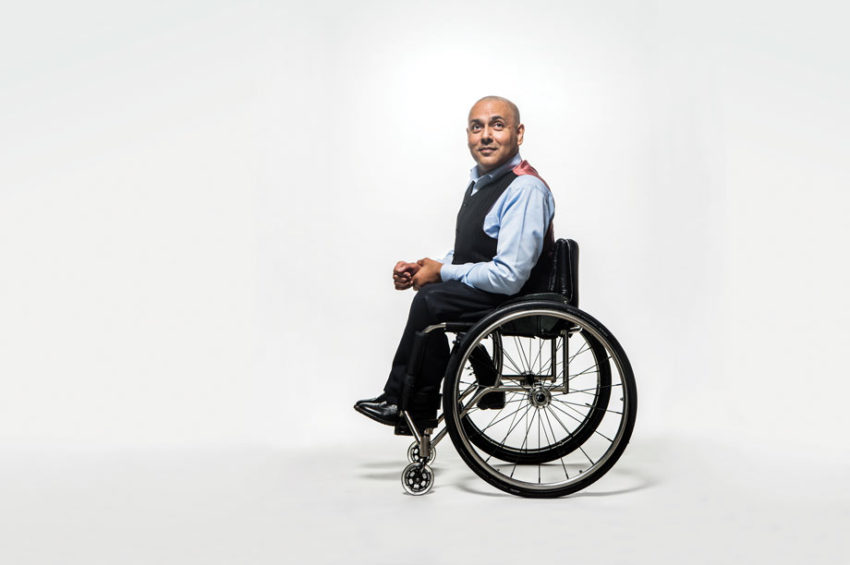Fear is the key that often locks the doors to employment for people with disabilities. And, it works both ways.
Employers fear that disabled people will be an expensive burden – they see the disability rather than the ability. For employees, the fear is that companies won’t hire them or they hide their disability and worry about being found out.
Kamran Mallick, Chief Executive of Disability Rights UK, has first-hand experience of workplace discrimination. He recalls early on in his career spending a year sending off CVs and, on informing potential employers that he was a wheelchair user, was never offered an interview.
“It was always, ‘the job’s not available anymore, but we’ll be in touch if anything else comes up,'” says Kamran. “But I never heard from them again.”
Overcoming the fear
In his previous role, he was involved in pioneering and running supported internship programmes with big international companies for people with learning difficulties.
“Once we overcame the fear hurdles and got it going, the head of HR of one of the companies said the internship had done more to change the culture than all the training courses and seminars they’d held in the past,” he explains. “You might learn something in theory but, if you never apply it, it never becomes embedded.
“There’s a lot of data that shows that employing a disabled person doesn’t cost more. There are government support schemes such as the Access to Work scheme. Disabled people tend to stay loyal to their employer longer than everybody else and take less sick leave. But the main positive for me about employing disabled people is the diversity of experience that they bring to a business.”
Voice for disabled people
Disability Rights UK is a national organisation acting as the voice for disabled people, including those with long-term health issues, such as Parkinson’s or arthritis. The rationale being that the life experience for someone with one of these conditions is often the same as for disabled people.
As Kamran explains: “They may not regard themselves as having a disability. So, we act as a voice for them and try and promote a more inclusive and rights-based society.”
His organisation does this through engaging with government ministers and working with businesses to change their perception of disability, bring about a cultural change and view a person who has a disability as an asset who can add value through diversity of thought.
Throughout most of his career, Kamran feels that disability has been on the wrong corporate agenda. It’s been linked to CSR (corporate social responsibility) rather than a main company objective.
The poor relation
“Disability has been the poor relation of everything else,” he argues. “However, in the last few years, I’ve seen a bit of a shift through things like The Valuable 500. So, we’re starting to get it on the agenda, but there’s a long way to go. For example, big companies will say to me that they are focusing on women.”
Kamran points out that disability includes other areas of diversity and not addressing it is a disservice to any diversity and inclusion plan. He recently attended a seminar which, he says, was the first time he’d seen a whole day dedicated to disability. Usually, it was just one workshop.
One problem is that there is “no positive narrative about disability and disabled people,” he explains. “People fall into the trap of thinking they’ve got to know all about the health condition. Why does that matter? What matters is, what are the barriers that people are experiencing? We must start to normalise the conversation about disability.
A good example is the mental health debate. It’s no longer a taboo subject – we all talk about it now. That’s as it should be, and I want the same conversation about disability to be normalised in the workplace.”
The important thing was to focus on achievement in the way that Paralympian Johnny Peacock is recognised first for his athletic prowess.
More creative recruitment
One of the main barriers to disabled people entering the workplace is the way companies promote themselves; the terminology they use. Says Kamran: “When they talk about being a flexible organisation, what are the examples of that? How will I, as a disabled person, benefit from your agile or flexible working? Do I see my reflection in your imagery? If I don’t see my reflection, you think it’s not an organisation for me.”
He believes that companies need to be more creative in the way they recruit to attract a more diverse workforce. For example, Disability Rights UK suggests using work trials. Candidates can then demonstrate, with some support, their ability to do the job and to learn. Then, when they are taken on, make sure they experience an inclusive environment.
“We talk about reasonable adjustments in the workplace,” Kamran says. “I’m in favour of making sure that reasonable adjustments are open to every single member of staff, not just disabled staff. If you’re a parent with young children, you might want to start a bit later so you can drop the kids off at school. Why not?”
Role models
He has found that having role models in a business is a good way of kicking off the conversation around disability; people who are willing to speak out about how the company has supported them. Staff networks that are more than just a talking shop – they result in positive actions – also help to raise the profile on disability. Finally, it should be on the agenda at board level.
Role models can help with disclosure as there is often a discrepancy between that and the numbers of people who have revealed their disability anonymously in a survey.
“You have to ask why people are not disclosing,” Kamran explains. “It could be because of fear of what has happened to them in the past or what might happen. You need to have systems and processes so that people coming into your organisation are inducted into a culture of openness. There’s probably a lot to learn from how businesses have responded to what has been done on other protected characteristics. Then asking ‘how do we apply that to disability’?”
He cites the financial industry and the media as encouraging people with disabilities. In particular, Channel 4, which is working hard on diversity behind the camera, as well as in front, on the screen.
Start in schools
But, the way to drive real change in society is at school. As Kamran points out: “It’s very difficult to change the core values of someone who’s in their 30s or 40s. But young people are more of a clean slate. Children from a young age start to think about what’s fair and unfair. When you get people to learn together, to live together, work together, they will carry that message for the rest of their lives. They’ll make friends who are diverse and inclusive.”
One of the aims of Disability Rights UK is encouraging more young people into the organisation. It is also focusing on how technology will help disabled people in future. The view is that there should be a shift away from assistive technology towards tools that are inclusive for everybody.
Kamran argues that “as soon as you add the words assistive tech to something, it creates them and us again. It’s a niche market, and it can be expensive. But then things like touchscreen and voice assistance are used by everyone. If you ask most people, they would never think they were designed
Ultimately, compliance and legislation will, he says, “start to raise the bar” on disability inclusion. The gender pay gap showed that, once it became a legal requirement, employers had to report on it.
But Kamran concludes that any legislation will need, “teeth and to be properly enforced. And legislation is the bare minimum and mere compliance which is not the goal. What we need to do is go beyond compliance to instil a culture of fairness in the workplace. When you frame the conversation about inequality around fairness, it’s harder to argue against.”







